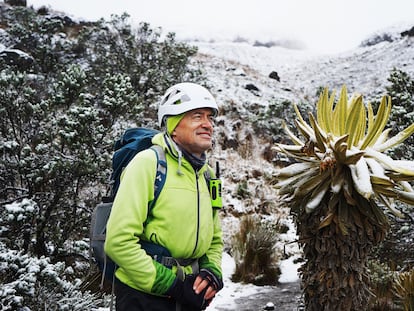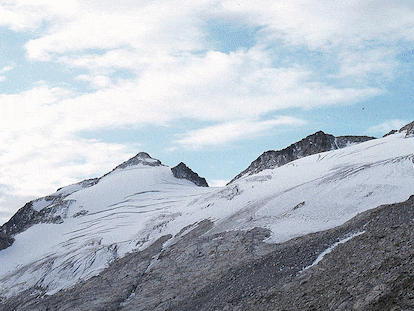The Chilean explorer documenting the death of glaciers at the ends of the earth
Cristian Donoso has spent the past three decades witnessing the melting of the world’s ice sheets. Following in the footsteps of historic expeditions, he replicates photographs taken by adventurers and scientists from the past to compare the current state of the planet’s glaciers. ‘Almost all of them are melting,’ he says

Night has fallen, and a fat moon reflects in the waters of the Beagle Channel, known in the native Yaghan language as Onashaga. The explorers are fine-tuning the last details of the voyage, which will take Cristian Donoso (47), Camilo Hornauer (44), Harry Brito (34), Cristóbal Clement (24) and the captain, Jorge Caros, to the España fjord’s Cattigara Glacier — a four-hour trip by boat from Puerto Navarino, Chile. They are travelling to the southernmost tip of the country, to the ends of the earth: Tierra del Fuego.
Clement packages oatmeal into seven-ounce rations. As with every expedition, they will alternate between two meals, eating oatmeal one day and ravioli the next. This will also be their only food once they reach Cattigara and attempt to climb Mount Darwin.
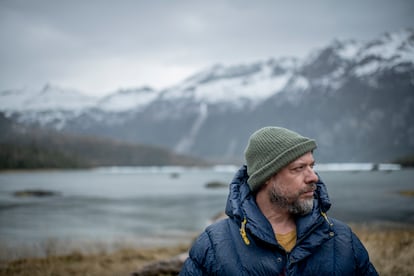
“It’s simpler that way. It gets the job done and we forget about being hungry,” explains Donoso, an explorer with over 100 extreme routes in Antarctica and Patagonia under his belt, and the leader of the current expedition, which this time plans to repeat the journey and replicate the photos taken in 1962 by Chilean geologist Cedomir Marangunic and English mountaineer Eric Shipton, along with their crew.
“And for water? What will you drink?
“Melted snow.”
The team knows what they’re in for. On every expedition, they typically lose about 37 pounds, walking between 10 and 15 hours a day and carrying roughly 450 pounds of photo equipment, food and shelter between them.
“There are days when we climb more, and days when we climb less, depending on the terrain and snow conditions,” Hornauer say.
“But we have reserves,” Donoso says, laughing and patting his belly like a drum.
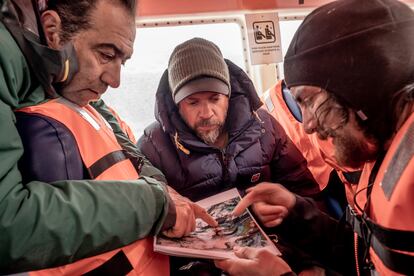
The plan dates back to 2018, when Donoso decided to follow the routes of past explorers through Chilean Patagonia, with the aim of recreating the photos taken on those earlier voyages and comparing the past images with the present ones. The project, titled Postcards of Ice, shows the stages of glacial retreat in Chile, as the ice sheets melt away. The team’s first voyage followed the route of Alberto de Agostini, and the second, the expedition of the German pilot Gunther Plüschow.
Using a map and by closely observing the terrain, they located the same places and determined the same perspectives that those historic explorers used to take the first images of the glaciers, employing box cameras and negatives etched on glass plates.
In 1914, the Salesian priest Alberto de Agostini photographed the Negri glacier. After 104 years, Cristian Donoso and Alfredo Pourailly captured the same perspective. The difference was shocking: in just 100 years, the glacier had melted away. A similar fate befell the Schiaparelli glacier, photographed the same year by De Agostini and again by Donoso and Pourailly in 2021. The Vergara glacier had also melted: in 1928, Gunther Plüschow documented the massive ice sheet, and 93 years later, in 2021, Pourailly and Donoso documented its demise. The same was also the case for the Pupum, Marinelli, and Louis de Savoie glaciers. All had a smaller volume of ice compared to the images from a century ago.
Concentrated in the southern zone of Chile (Aysén and Magallanes) are a total of 15,014 ice formations, equivalent in volume to 600 cubic miles of water. In the past 15 years, the country’s glacial surface has been fragmented, and 8% of the total ice volume has been lost, according to the latest glacier inventory carried out by Chile’s Dirección General de Aguas in 2022.
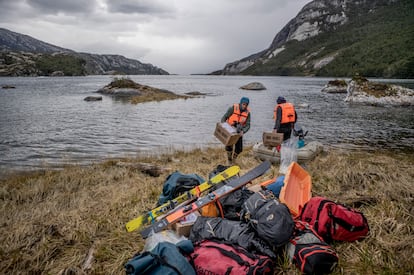
Cristian Donoso has been studying unexplored and extreme places for 30 years, and he has no doubts about the retreat of Patagonia’s glaciers: “I always go back, so I’ve become a witness to the profound and accelerated transformation of the landscape. There used to be places where you couldn’t get through because there was a glacier, and now I go back and the glacier is gone,” he says, the night before setting sail for Cattigara. Patagonia and its glaciers are a testament to the global consequences of human actions, Donoso insists: “What we are seeing is an acceleration of the melting of ice due to global warming. The speed of melting has increased exponentially.” The explorer and academic at Chile’s Universidad del Desarrollo adds another important point: “Before, in order to damage an area of land, humans had to physically destroy it, cut down forests, pollute rivers. Now, actions that occur thousands of kilometers away, even in the northern hemisphere, have global consequences.”
It’s late in the afternoon. The explorers have packed up everything they will need: cameras, bags, tents, solar chargers and a feast for the last day (water, cheese, maté and thick bars of chocolate. “We’ve spent the hour talking, now we have to sleep,” says Jorge Caros, the captain and owner of the Loica, the boat that will take the team from the dock of Navarino Island to the deepest part of the España Fjord tomorrow morning.
Aboard the ‘Loica’
The sun rises. First thing in the morning, crew member John Cano and crab fisherman Eugenio Calderón, the son of the last surviving Yaghan native speaker, Cristina Calderón, who died in 2022 from covid, join the team. Eugenio knows the waters of the Beagle as well as the living and dead of the Ukika village where the last Yaghan people live — an ethnic group devastated by the arrival of the region’s first settlers.
“When we were kids, we used to play all day in canoes,” he says, sitting on a wooden bench with his hands folded on his legs. “My mother used to get angry because we would get soaking wet, but we never got sick! We were free and healthy.”
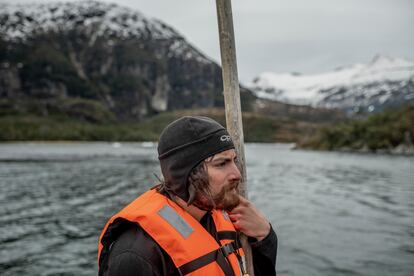
It’s time to leave. The song Óleo de una mujer con sombrero by Silvio Rodríguez plays in the background.
Camilo Hornauer, one of the explorers, an entrepreneur, and the president of the conservation organization Fundación Plantae, cuts down some PVC pipes with a pocket knife.
“They have to be one meter tall,” he explains.
“And what do you do with them?” John asks.
“They’re flags, to mark dangerous areas, places where there are cracks in the ice,” Hornauer says.
Harry Brito opens up a map that traces the route of former explorers Cedomir Marangunic and Eric Shipton. The crew members run their fingers along the path of their journey, tracing their route through the islands and islets of the Beagle Channel.
“This is where we enter,” says Donoso.
From a window, their Yaghan crewmate points towards a small glacier, the Romanche.
“When I was a kid, that glacier reached all the way to the canal,” he says.
We look toward the distant ice, trying to imagine it: today, the Romanche is half of what it once was.
Problems at Onashaga
The windows of the boat fog up as a drizzle of rain begins to fall. Bad weather is coming. The captain can’t see ahead and asks John Cano to clean the glass on the outside of the boat. As John works on clearing the captain’s field of vision, an emergency alarm goes off: something has jammed the propeller of an engine. Cano and Calderón manage to free the obstruction. Three minutes later, the propeller gets tangled up in an underwater forest of huiro, a type of brown kelp algae commonly found in the Beagle Canal. Captain Caros shuts off the engines.
After rescuing the propeller three times, the Loica forges ahead until it reaches the mouth of the España fjord. There, another problem arises: the ice could break the propellers if they advance to the end of the fjord, which is where they hope to photograph the Cattigara glacier before ascending Mount Darwin.
“If you do it slowly, you can make it,” Cristian Donoso tells the captain.
“I need you to move the ice with an oar. This isn’t an icebreaker,” Caros says.
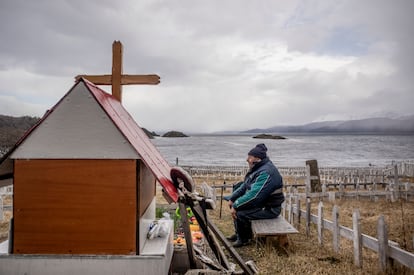
Several crewmates grab some oars and positions themselves at the bow to push the ice away and clear a path. Others do the same at the stern: they keep the ice from crashing into the boat. The wind is blowing hard, and the cold chills to the bone. Crac, tac, tac, tac, tac, sounds the shell of the ship, jostled by the shifting ice.
“The hull will open up the route, but you have to keep moving forward,” Hornauer tells the captain.
Chunks of ice slam into the keel. The captain rubs his face with his hands. We move forward at two knots per hour, but the ice does will not let us cross the fjord. We are approaching a layer of densely packed ice. Trapped in frozen water, there’s no easy way out. The Loica is slowly moving backwards. The crew is clearing the ice floes out of the way. They reach a shoreline and tie up the boat.
“We’re going to see if there’s another way through up ahead,” Donos says.
And together they decide to explore in the zodiac. As they prepare to head off, they notice the motorboat’s engine isn’t working properly.
“What’s the worst that could happen?” Clement asks.
“We could get stuck without a motor or fuel, out here, in the middle of nowhere,” Hornauer responds.
“What should we do?” Brito asks.
Donoso convenes an emergency meeting.
John, the boatman, whispers to Eugenio, the Yaghan accompanying the adventure: “You have to obey nature when she decides to not let you pass.” Eugenio nods.
The explorers decide to continue their journey on foot. Carrying all of their equipment on their backs.
“When the ice opens up, we’ll keep going in the little rubber boat. The situation may change as the days go by, all is not lost,” Donoso says optimistically.
The explorers disembark the Loica and start setting up their first camp. This is where they will spend the night, and the next two nights: under a forest of Patagonian colihue bamboo, and far from their destination. The rest of the crew sleeps at sea, rocked by the waters of the Onashaga.
One final gamble
The explorers wait two days and two nights for the ice to shift and clear a passage. But when they begin to realize that this isn’t happening and won’t happen anytime soon, they devise a plan B: climb up along a different latitude and descend from there, walking and carrying their gear to the Cattigara glacier. Added to this difficulty is another: the expedition leader has come down with a nasty cold.
In spite of everything, on October 2, Cristian Donoso sent the following message to Jorge Caros on his InReach, an Iridium satellite communication device: “We’ve already carried up the gear. Tomorrow we hope to reach the ice field.”
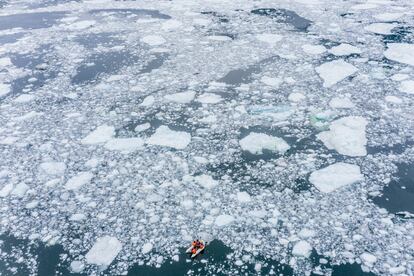
The team had ferried their supplies by boat. When they tried to climb the hill, they discovered that it was as simple an ascent as they had thought. With the move to the new base camp, we had exhausted half of the fuel left in the Loica, which meant we couldn’t make another move, nor did we have enough fuel for the return journey. It was like playing chess with the open sea.
In another message to the captain, Donoso asks him to get them in touch with a sailboat with an iron hull that could allow them to move through the ice more easily. Jorge Caros contacts the captain of the sailboat Serendipia. When his satellite phone rings, Caros is at the Puerto Williams patient health committee meeting.
“Hello? Yes, of course, I’ll go with you.”
At 11:30 p.m., the Serendipia sets sail from the Micalvi Yacht Club to the point the explorers had marked on a satellite map.
At 5:30 p.m. the next day, the vessel arrives at the rendezvous point. The explorers bring up the cargo and the dinghy. The ice has now melted and the entrance is clear. They proceed slowly, at three or four knots. Sometimes coasting in neutral. On the southern edge of the channel there is an opening between the ice sheets. They advance stealthily toward the end of the fjord, very close to the Cattigara glacier.
For a base camp, they choose the only possible location, the only spot without cliffs and slopes: a stretch of forest abutting a stream. The mountains are high and block the sun, creating a kind of cold chamber in the fjord.
They reach the Cattigara glacier. There, they locate the same position from which Cedomir Marangunic took his original pictures in 1962. They get the image. Then Donoso sends an InReach message with the bad news: the Cattigara glacier has retreated 500 meters.
That night Donoso falls ill. More than before.
He sends one last message before settling in to weather the storm, curled up and coughing in a subzero sleeping bag: “My cold got worse and the weather conditions have also worsened. The wind and snowstorm are giving us no respite. Our tents are buried under the snow. Day and night we have to go out with shovels to dig.
“It’s time to come home,” the glacial explorer announces via InReach. They have the last photo: one more piece of evidence of climate change, taken from the heart of the world’s icy reaches.
A centruy of melting ice
In 1913, the Salesian priest Alberto de Agostini arrived at the glaciers of the Darwin Cordillera with a box camera. He was called “the extreme priest” because he would go out to photograph the ice wearing only a cassock and leather shoes. His negatives for the photographs were glass plates, which are still preserved in the Magiorino Borgatello Museum in Punta Arenas. In 2018, explorers and documentary filmmakers Cristian Donoso and Alfredo Pourailly wanted to photograph the places the priest visited. They found the same mountains and fjords, but no trace of the same ice.
Cattigara Glacier
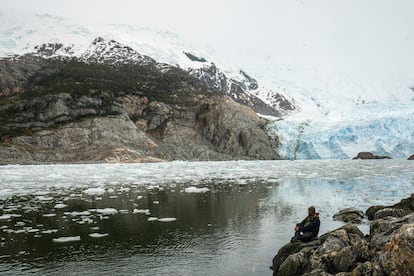
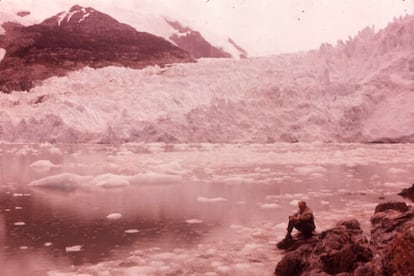
Marinelli Glacier
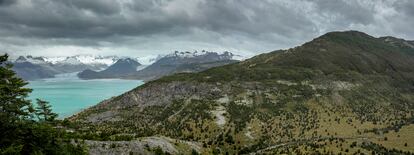
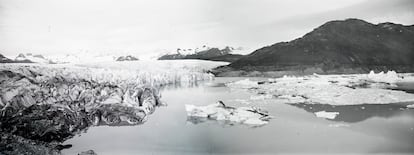
Marinelli Glacier
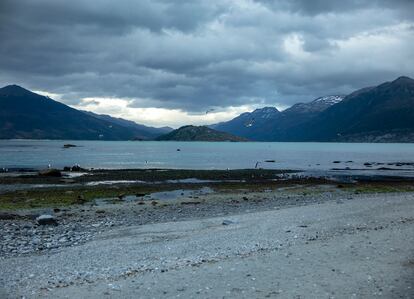
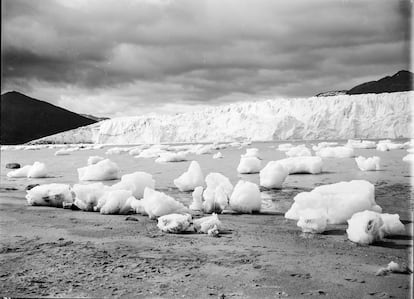
Negri Glacier
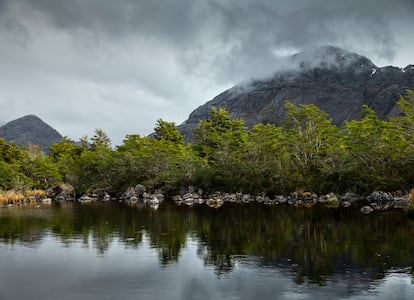
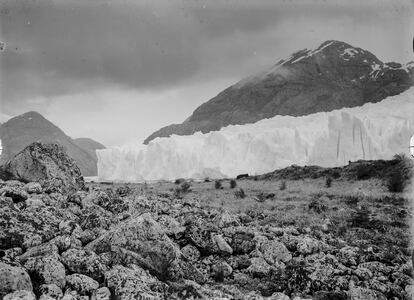
Negri Glacier
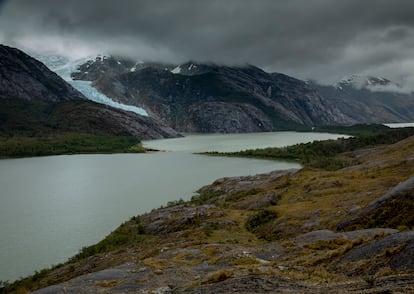
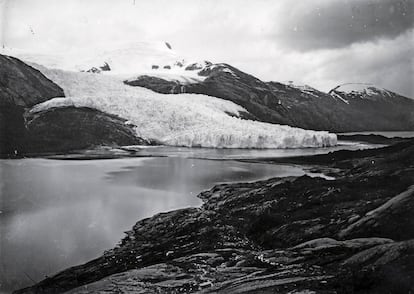
Parry Glacier
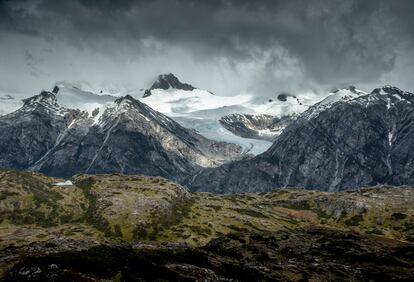
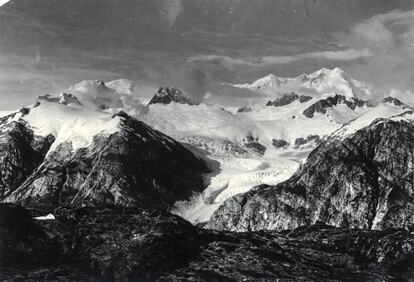
Sign up for our weekly newsletter to get more English-language news coverage from EL PAÍS USA Edition
Tu suscripción se está usando en otro dispositivo
¿Quieres añadir otro usuario a tu suscripción?
Si continúas leyendo en este dispositivo, no se podrá leer en el otro.
FlechaTu suscripción se está usando en otro dispositivo y solo puedes acceder a EL PAÍS desde un dispositivo a la vez.
Si quieres compartir tu cuenta, cambia tu suscripción a la modalidad Premium, así podrás añadir otro usuario. Cada uno accederá con su propia cuenta de email, lo que os permitirá personalizar vuestra experiencia en EL PAÍS.
¿Tienes una suscripción de empresa? Accede aquí para contratar más cuentas.
En el caso de no saber quién está usando tu cuenta, te recomendamos cambiar tu contraseña aquí.
Si decides continuar compartiendo tu cuenta, este mensaje se mostrará en tu dispositivo y en el de la otra persona que está usando tu cuenta de forma indefinida, afectando a tu experiencia de lectura. Puedes consultar aquí los términos y condiciones de la suscripción digital.
More information
Archived In
Últimas noticias
There is as much life left to discover on planet Earth as that which is already known
Dozens presumed dead, around 100 injured in fire at Swiss Alps bar during New Year’s celebration
Is porn for women different from conventional porn? We spoke to those who make it
Cartagena de Indias is sinking: What can the city do to mitigate it?
Most viewed
- Sinaloa Cartel war is taking its toll on Los Chapitos
- Reinhard Genzel, Nobel laureate in physics: ‘One-minute videos will never give you the truth’
- David King, chemist: ‘There are scientists studying how to cool the planet; nobody should stop these experiments from happening’
- Oona Chaplin: ‘I told James Cameron that I was living in a treehouse and starting a permaculture project with a friend’
- The Interoceanic Train, the Mexican alternative to the Panama Canal
